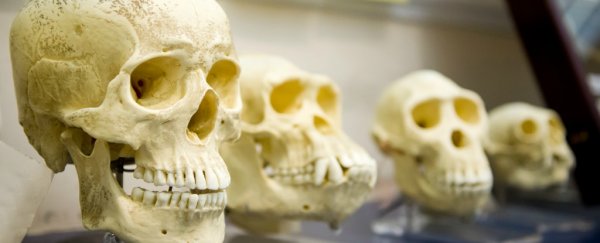Homo sapiens, in our most "modern" form, have been roaming the earth for about 200,000 years now.
But there's something rather special about the way our brains look today: human skulls are rounder, faces are smaller, and more retracted into the skull. It's different from the way our ancestors looked, more than a hundred thousand years ago.
And now, for the first time, scientists say they've pinpointed precisely when they believe we grew into our modern skulls.
 (Simon Neubauer, Philipp Gunz, MPI EVA Leipzig)
(Simon Neubauer, Philipp Gunz, MPI EVA Leipzig)
Above: The blue brain shows the globular shape of present-day human heads. In contrast, the red skull shape of a Neanderthal, like the earliest Homo sapiens fossils, is elongated.
Research published Wednesday in the journal Science Advances by a team at the Max Planck Institute for Evolutionary Anthropology in Germany says there's something distinct about the way our brains and skulls look now, and it likely developed around 40,000 years ago.
Compared to our ancestors, the modern head shape features a bigger, rounder cerebellum (that's the area in the back of the brain, responsible for things like motor control and balance, as well as some memory and language).
We also have more a bulging, rounded parietal lobe (which helps us orient, plan and pay attention), and smaller, more retracted faces than our predecessors.
The side walls of the brain became more parallel, the frontal area became taller, and the occipital area, in the back of the head, shifted to a rounder, less "overhanging" shape.
What's remarkable about the find is that our brain shape changes track almost perfectly with the development of modern behaviors, like carving tools, planning, developing self-awareness, languages and even the first cave drawings.
In other words, that so-called "human revolution" of around 40,000 years ago, sometimes referred to as the "great leap forward" happened right around the time we were getting comfy in our newer skulls.
As the researchers point out, this didn't all happen overnight, but instead was the result of tens of thousands of years of slight changes.
They can't say for sure yet when our brains made the switch, but they're pretty sure it was "at some point after about 100,000 years ago and probably before 35,000 years ago."
Using 3-D scanning techniques to examine curves, shapes and features of 20 different Homo sapiens fossils, ranging from 300,000 years to 10,000 years old, the researchers have developed a groundbreaking theory: our modern ways would probably not have been possible without our rounder, more elegant brains.
"It is important to note that it is probably not the globular brain shape itself that is advantageous for brain function," Simon Neubauer, the anthropologist who led the research, told Business Insider in an email.
Instead, he says the rounder features that develop in humans' first few months of life are simply "related to our [modern] behavior," but not causing it.
This article was originally published by Business Insider.
More from Business Insider:
